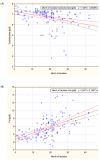Breast Milk Macronutrient Components in Prolonged Lactation
- PMID: 30513944
- PMCID: PMC6316538
- DOI: 10.3390/nu10121893
Breast Milk Macronutrient Components in Prolonged Lactation
Abstract
Human milk (HM) is the first dietary exposure in infancy and the best nutritional option for growth and healthy development of the newborn and infant. The concentrations of macronutrients, namely proteins, carbohydrates and lipids, change during lactation stages. HM has been studied extensively in the first 6 months of lactation, but there are limited data regarding milk composition beyond 1 or 2 years postpartum. The aim of our study was to describe longitudinal changes in HM macronutrient concentrations during the prolonged lactation of healthy mothers from the 1st to the 48th month. For the macronutrient content of milk of mothers breastfeeding for longer than 18 months, fat and protein increased and carbohydrates decreased significantly, compared with milk expressed by women breastfeeding up to 12 months. Moreover, the concentration of fat, protein and carbohydrates in HM over 2 years of lactation from the 24th to the 48th month remained at a stable level. However, analyzed macronutrients were positively (carbohydrate, r = 0.51) or negatively (fat, r = -0.36 and protein, r = -0.58) correlated with the amount of feeding. Our results create a greater potential for understanding the nutritional contribution of HM over 2 years of lactation and showed that the source of calories in breast milk for older children is mainly fat, while carbohydrates play a greater role in infant nutrition in the early stage. The observed changes of macronutrient concentrations from the 1st to the 48th month of lactation are probably related to the adaptation of milk composition to the increased energy demand of the intensively growing child.
Keywords: breastfeeding; child nutrition; macronutrients; prolonged lactation.
Conflict of interest statement
The authors declare no conflict of interest.
Figures





References
-
- World Health Organization. United Nations Children’s Fund . Global Strategy for Infant and Young Child Feeding. World Health Organization; Geneva, Switzerland: 2003. p. 30.
-
- Gartner L.M., Morton J., Lawrence R.A., Naylor A.J., O’Hare D., Schanler R.J., Eidelman A.I. American Academy of Pediatrics Section on Breastfeeding. Breastfeeding and the use of human milk. Pediatrics. 2005;115:496–506. - PubMed
-
- Breastfeeding. [(accessed on 20 June 2018)]; Available online: http://www.who.int/maternal_child_adolescent/topics/newborn/nutrition/br...
-
- Infant and Young Child Feeding. [(accessed on 20 June 2018)]; Available online: http://www.who.int/mediacentre/factsheets/fs342/en/
MeSH terms
Substances
LinkOut - more resources
Full Text Sources
Medical

